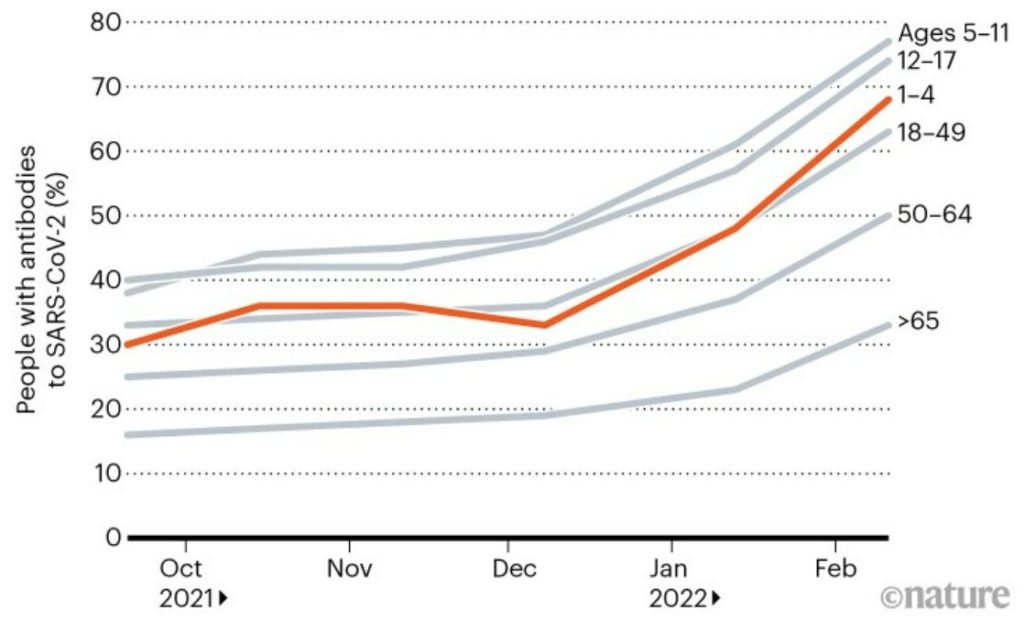A countrywide study found SARS-CoV-2 in nearly two-thirds of children aged one to four years old.
According to a nationwide analysis, around two out of every three children aged one to four years old in the United States have been infected with SARS-CoV-2. During the Omicron wave, infections in that age group increased more than in any other, demonstrating the variant’s high transmissibility, according to researchers.
More than 86,000 blood samples from children under the age of 18 were screened for COVID-19 antibodies, including 6,100 samples from infants between the ages of 1 and 4. Between December 2021 and February 2022, the infection rate among young children more than doubled, rising from 33 percent to 68 percent.
Although the study only included a limited number of very young infants, Pamela Davis, a physician and medical researcher at Case Western Reserve University in Cleveland, Ohio, says the findings are consistent with the dramatic rise in recorded infections in that age group.
Overall, the scientists determined that by February of this year, the majority of children aged 1 to 17 had been infected. Children aged 5 to 11 had the highest infection rate, at 77 percent. Children’s infection rates are higher than adults’ (see ‘Omicron spike’).

According to Fiona Russell, a paediatrician and infectious-diseases epidemiologist at the University of Melbourne in Australia, these are significant findings, particularly for low- and middle-income countries where adult vaccination rates are low and children are unlikely to be vaccinated for some time. Although the immunity developed by an infection may assist to avoid future infections and serious disease in children, “the pandemic is not over until children worldwide are also offered vaccination”.
COVID-19 infections reported in the United States imply that 17 percent of children under the age of 18 are infected. “That’s just the tip of the iceberg,” says Kristie Clarke, the study’s lead author and a medical epidemiologist at the US Centers for Disease Control and Prevention in Atlanta, Georgia. Because many silent and moderate infections are likely not detected, reported cases based on PCR and antigen testing vastly underestimate the true rate of infection, especially in children.
Clarke and her colleagues tested for antibodies against SARS-CoV-2 in residual blood samples taken during clinic visits between September 2021 and February 2022 to determine the scope of unreported infections. They looked for antibodies that target a specific protein on the SARS-CoV-2 virus that isn’t present in the COVID-19 vaccinations used in the US, indicating that children got immunity from infection rather than immunization.
Children’s high infection rates are reflected in hospitalization data in the United States. During the top of the Omicron wave, the number of children under the age of five admitted to hospitals with COVID-19 was 5 times higher than during the peak of the Delta wave, and admissions to critical care were 3.5 times higher.
Many variables, including the fact that children under the age of five are not eligible for vaccination and are less likely to wear masks or practice social distance than older children and adults, could explain the increased illnesses in toddlers and preschoolers, according to Clarke.
According to Shabir Mahdi, a vaccinologist at the University of the Witwatersrand in South Africa, the findings are remarkable but not surprising, and “might well have underestimated the force of infection during the Omicron wave.” Antibody testing can’t determine if someone has been infected several times, and he believes they may have missed some infections due to diminishing antibody levels over time. According to Madhi, the antibody test employed in the study only captured roughly 80 percent of illnesses that might be diagnosed using a different antibody test.
According to studies, children infected with Omicron had a lesser risk of serious sickness than children infected with Delta. Davis and Rong Xu, a data scientist at Case Western Reserve University, looked at over 650,000 children under the age of five in the United States and observed that their risk of getting severe disease during the Omicron wave was about one-third that of the Delta wave, as measured by emergency hospital visits between November 2021 and January 2022. According to Xu, it will be critical to consider the long-term consequences of the increase of children.
According to Madhi, hospitalization rates in children have been significantly lower than those in older age groups.
“Children have been spared,” he adds. “We should be thankful for that.”
Image Credit: Getty
You were reading: Two in three children under age 4 in the US are infected with Omicron
